Understanding the Spread of COVID-19 in China: Spatial–Temporal Characteristics, Risk Analysis and the Impact of the Quarantine of Hubei Province on the Railway Transportation Network
Abstract
:1. Introduction
2. Data and Methods
2.1. Study Areas and Data Sources
2.2. Main Research Methods
2.2.1. Node-Degree Centrality
2.2.2. Average Network Path Length
2.2.3. Overall Network Characteristic Evaluation Index
3. Analysis of Temporal and Spatial Processes of Epidemic Growth
3.1. The Epidemic Situation Showed an S-Shaped Curve
3.2. Epidemic Growth Rate in Hubei Declined Steadily after 12 February
3.3. The Outbreak Was More Serious in Surrounding Areas of Hubei and in Cities with Higher Economic-Activity Intensity
4. Epidemic-Risk Analysis
4.1. Average Incubation Period of COVID-19 Is Approximately 4 Days
4.2. Ratio of Number of Cured People to That of Deaths Gradually Increased, Indicating That, Given Sufficient Medical Resources, the Cure Rate Can Be Greatly Improved
5. Impact of Provincial Quarantine Measures on China’s Railway Traffic
5.1. Quarantine in Hubei Had Greater Impact on Cities with Higher Centrality
5.2. Hubei Quarantine Had Weak Impact on Overall Connectivity of National Railway Network
5.3. Quarantine in Hubei Province Had Great Impact on the Outflow of Local People to Neighboring Provinces
6. Discussion and Conclusions
Author Contributions
Funding
Institutional Review Board Statement
Informed Consent Statement
Data Availability Statement
Conflicts of Interest
References
- Wang, J.; Zhao, S.M.; Liu, M.; Zhao, Z.; Xu, Y.; Wang, P.; Lin, M.; Xu, Y.; Huang, B.; Zuo, X.; et al. ACE2 expression by colonic epithelial cells is associated with viral infection, immunity and energy metabolism. MedRxiv 2020. [Google Scholar] [CrossRef] [Green Version]
- Zhu, Z.; Meng, K.; Meng, G. A database resource for genome-wide dynamics analysis of coronaviruses on a historical and global scale. MedRxiv 2020. [Google Scholar] [CrossRef] [Green Version]
- Zhang, C.; Zheng, W.; Huang, X.; Bell, E.W.; Zhou, X.; Zhang, Y. Protein structure and sequence re-analysis of 2019-nCoV genome does not indicate snakes as its intermediate host or the unique similarity between its spike protein insertions and HIV-1. J. Proteome Res. 2020. [Google Scholar] [CrossRef]
- Chang, D.; Lai, M.; Li, W.; Xie, L.; Zhu, G.; Cruz, C.S.D.; Sharma, L. Epidemiologic and Clinical Characteristics of Novel Coronavirus Infections Involving 13 Patients Outside Wuhan, China. JAMA J. Am. Med. Assoc. 2020, 323, 1092–1093. [Google Scholar] [CrossRef] [PubMed]
- Guan, W.J.; Ni, Z.Y.; Hu, Y.; Liang, W.H.; Ou, C.Q.; He, J.X.; Liu, L.; Shan, H.; Lei, C.L.; Hui, D.S.C.; et al. Clinical Characteristics of Coronavirus Disease 2019 in China. N. Engl. J. Med. 2020, 382, 1708–1720. [Google Scholar] [CrossRef]
- Joseph, T.W.; Kathy, L.; Gabriel, M.L. Nowcasting and forecasting the potential domestic and international spread of the 2019-nCoV outbreak originating in Wuhan, China: A modelling study. Lancet 2020, 395, 689–697. [Google Scholar]
- Cao, Z.; Zhang, Q.; Lu, X.; Pfeiffer, D.; Wang, L.; Song, H.; Pei, T.; Jia, Z.; Zeng, D.D. Incorporating Human Movement Data to Improve Epidemiological Estimates for 2019-nCov. MedRxiv 2020. [Google Scholar] [CrossRef] [Green Version]
- Park, S.W.; Bolker, B.M.; Champredon, D.; Earn, D.J.; Li, M.; Weitz, J.S.; Grenfell, B.T.; Dushoff, J. Reconciling early-outbreak preliminary estimates of the basic reproductive number and its uncertainty: Anew framework and applications to the novel coronavirus (2019-nCoV) outbreak. MedRxiv 2020. [Google Scholar] [CrossRef] [Green Version]
- Anderson, R.M.; May, R.M. Infectious Diseases of Humans: Dynamics and Control; Oxford University Press: Oxford, UK, 1991. [Google Scholar]
- Roberts, M.G.; Heesterbeek, J.A.P. A new method for estimating the effort required to control an infectious disease. Proc. R. Soc. B 2003, 2709, 1359–1364. [Google Scholar] [CrossRef] [PubMed]
- Heffernan, J.M.; Smith, R.J.; Wahl, L.M. Perspectives on the basic reproductive ratio. J. R. Soc. Interface 2005, 2, 281–293. [Google Scholar] [CrossRef]
- Kuchler, T.; Russel, D.; Stroebel, J. Insight: The geographic spread of COVID-19 correlates with the structure of social networks as measured by Facebook—ScienceDirect. J. Urban. Econ. 2021. [Google Scholar] [CrossRef]
- Engle, S.; Stromme, J.; Zhou, A. Staying at Home: Mobility Effects of COVID-19; Available at SSRN. 2020. Available online: https://papers.ssrn.com/sol3/papers.cfm?abstract_id=3565703 (accessed on 5 March 2020).
- Gilbert, M.; Pullano, G.; Pinotti, F.; Valdano, E.; Poletto, C.; Boëlle, P.-Y.; D’Ortenzio, E.; Yazdanpanah, Y.; Eholie, S.P.; Altmann, M.; et al. Preparedness and vulnerability of African countries against importations of COVID-19: A modelling study. Lancet 2020, 395, 871–877. [Google Scholar] [CrossRef] [Green Version]
- Christidis, P.; Christodoulou, A. The Predictive Capacity of Air Travel Patterns during the Global Spread of the COVID-19 Pandemic: Risk, Uncertainty and Randomness. Int. J. Environ. Res. Pub. Health 2020, 17, 3356. [Google Scholar] [CrossRef] [PubMed]
- Nikolaou, P.; Dimitriou, L. Identification of critical airports for controlling global infectious disease outbreaks: Stress-tests focusing in Europe. J. Air Transp. Manag. 2020, 85, 101819. [Google Scholar] [CrossRef]
- Gómez-Ríos, D.; Ramirez-Malule, D.; Ramirez-Malule, H. The effect of uncontrolled travelers and social distancing on the spread of novel coronavirus disease (COVID-19) in Colombia. Travel. Med. Infect. Dis. 2020, 35, 101699. [Google Scholar] [CrossRef]
- Wei, Y. Provincial Transmission of 2019-nCoV Simulation Based on Multi-Agent Network and Big Data of Population Mobility during. 2020. Available online: https://mp.weixin.qq.com/s?__biz=MzIyNDY0ODAxOQ==&mid=2247483994&idx=1&sn=7cb7533ba7d9f1f69a0a0547467cc6f2&scene=21#wechat_redirect (accessed on 5 March 2020). (In Chinese).
- Zhang, Y.; Gao, J. Which Urban Outbreaks are Likely to be Underestimated?—Prediction of Potential Infected Person Based on Population Flow and Confirmed Data. 2020. Available online: https://mp.weixin.qq.com/s/2Q8HmyQ8BhptoxrJ0A0_KA (accessed on 5 March 2020). (In Chinese).
- Xiang, Y.; Wang, S. Spatial Relationship between Epidemic Spread and Population Outflow of the Corona Virus Disease 2019 (COVID-19) That Impacted Chinese Urban Public Health Classification. Trop. Geogr. 2020, 40, 408–421. (In Chinese) [Google Scholar]
- Liu, T.; Jin, Y. The closer to Wuhan, the higher the incidence rate of. The reality may be more complicated. 2020. Available online: https://mp.weixin.qq.com/s/C8oCHG4ciMvTCrNkyuaPBA+ (accessed on 5 March 2020). (In Chinese).
- Du, F.; Wang, J.; Wang, H. The Impacts of COVID-19 on the Connectivity of China’s International Air Transport Network and the Spatial Differences. Trop. Geogr. 2020, 40, 386–395. (In Chinese) [Google Scholar]
- Miao, C.; Liu, Y.; Dong, G.; Yang, D.; Zhang, H.; Han, Y.; Ren, H.; Qi, Y. Analysis of 2019-nCoV epidemic situation in Henan Province. 2020. Available online: https://mp.weixin.qq.com/s/dU9xBm4LjLmXubzVODM1yw (accessed on 20 February 2020). (In Chinese).
- Wang, J.; Li, G.; Wang, J.; Qiang, J.; Zhu, D. Spatiotemporal Evolution and Risk Profiling of the COVID-19 Epidemic in Shaanxi Province. Trop. Geogr. 2020, 40, 432–445. (In Chinese) [Google Scholar]
- Liu, Y.; Li, Y.; Li, Z. Diffusion Characteristics of the Coronavirus Disease 2019 (COVID-19) Outbreak in Guangdong Province. Trop. Geogr. 2020, 40, 367–374. (In Chinese) [Google Scholar]
- Albert, R.; Barabási, A.L. Statistical mechanics of complex networks. Rev. Mod. Phys. 2002, 74, 47. [Google Scholar]
- Barabási, A.; Albert, R. Emergence of scaling in random networks. Science 1999, 286, 509–512. [Google Scholar] [CrossRef] [PubMed] [Green Version]
- Freeman, L.C. Centrality in social networks: Conceptual clarification. Soc. Netw. 1979, 1, 215–239. [Google Scholar] [CrossRef] [Green Version]
- Watts, D.J.; Strogatz, S.H. Collective dynamics of ‘small-world’ networks. Nature 1998, 393, 440–442. [Google Scholar] [CrossRef] [PubMed]
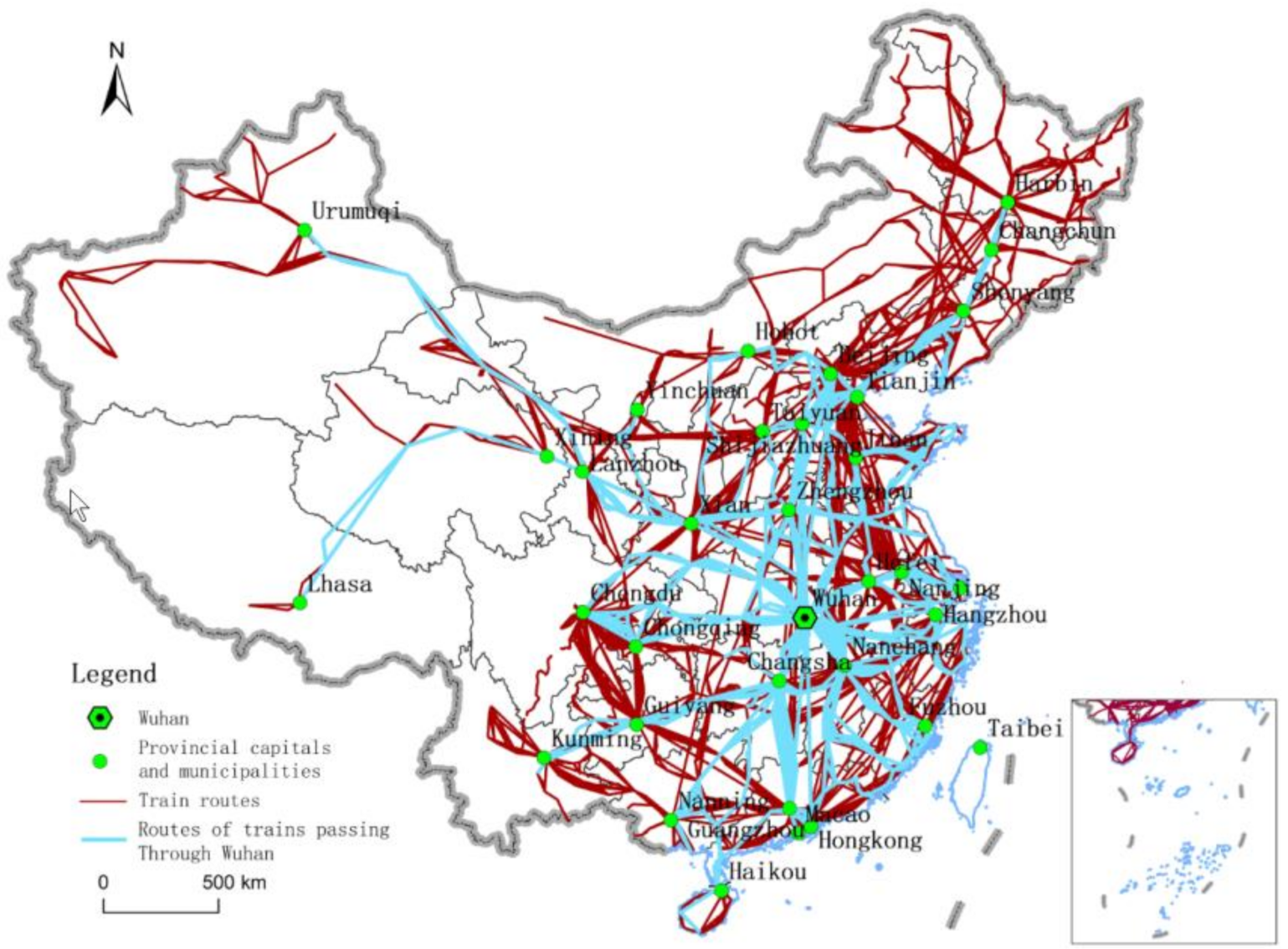
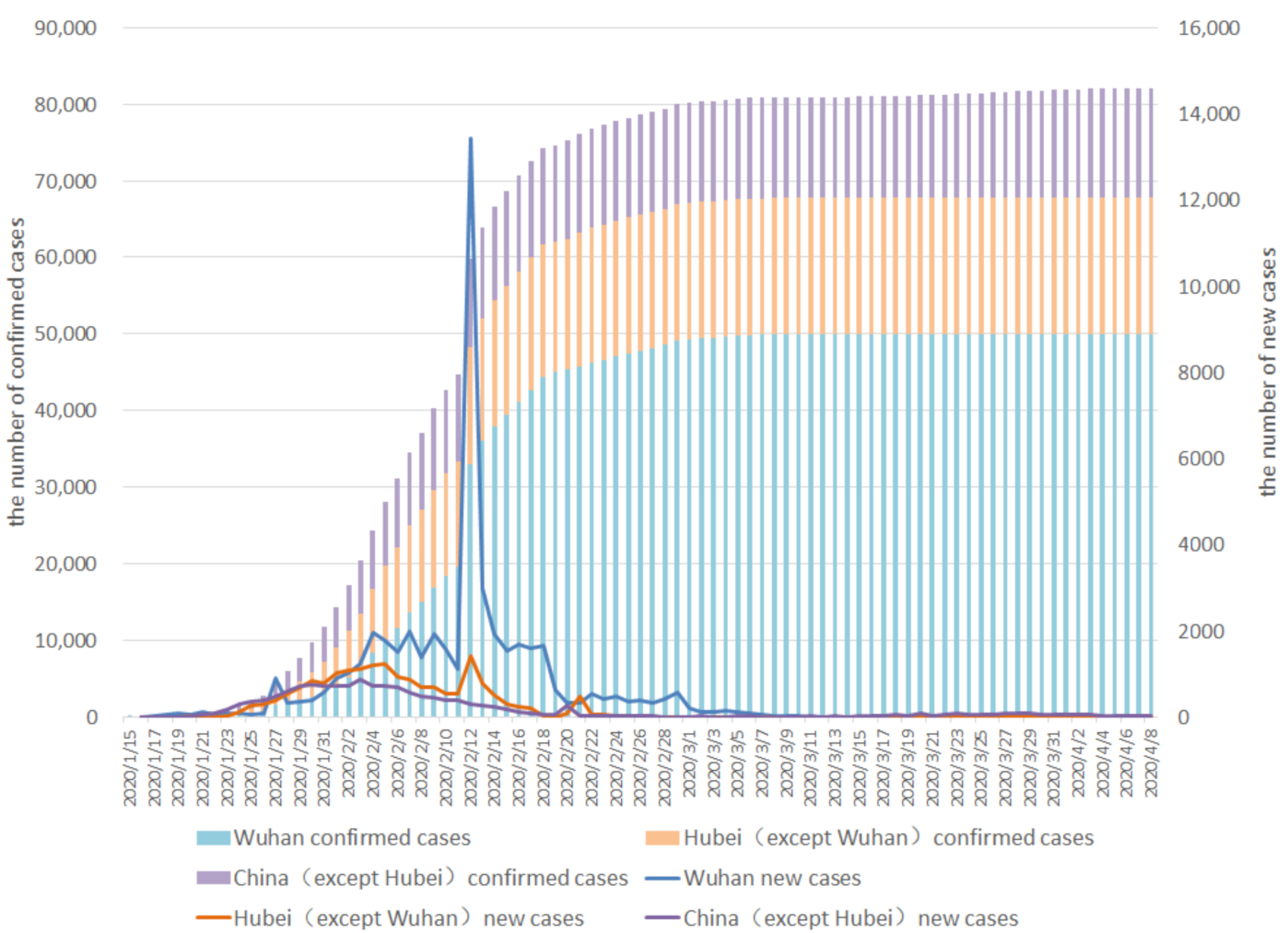
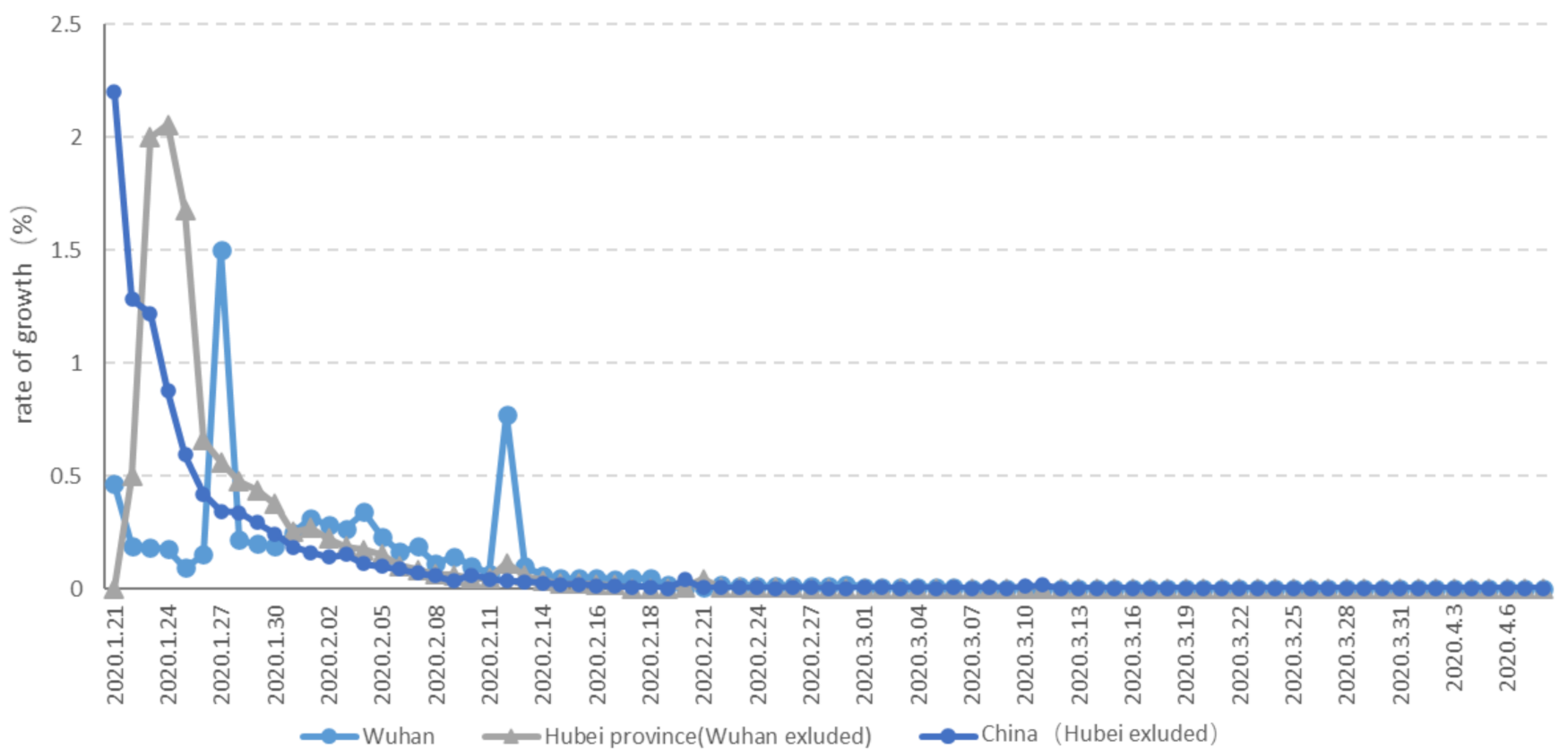
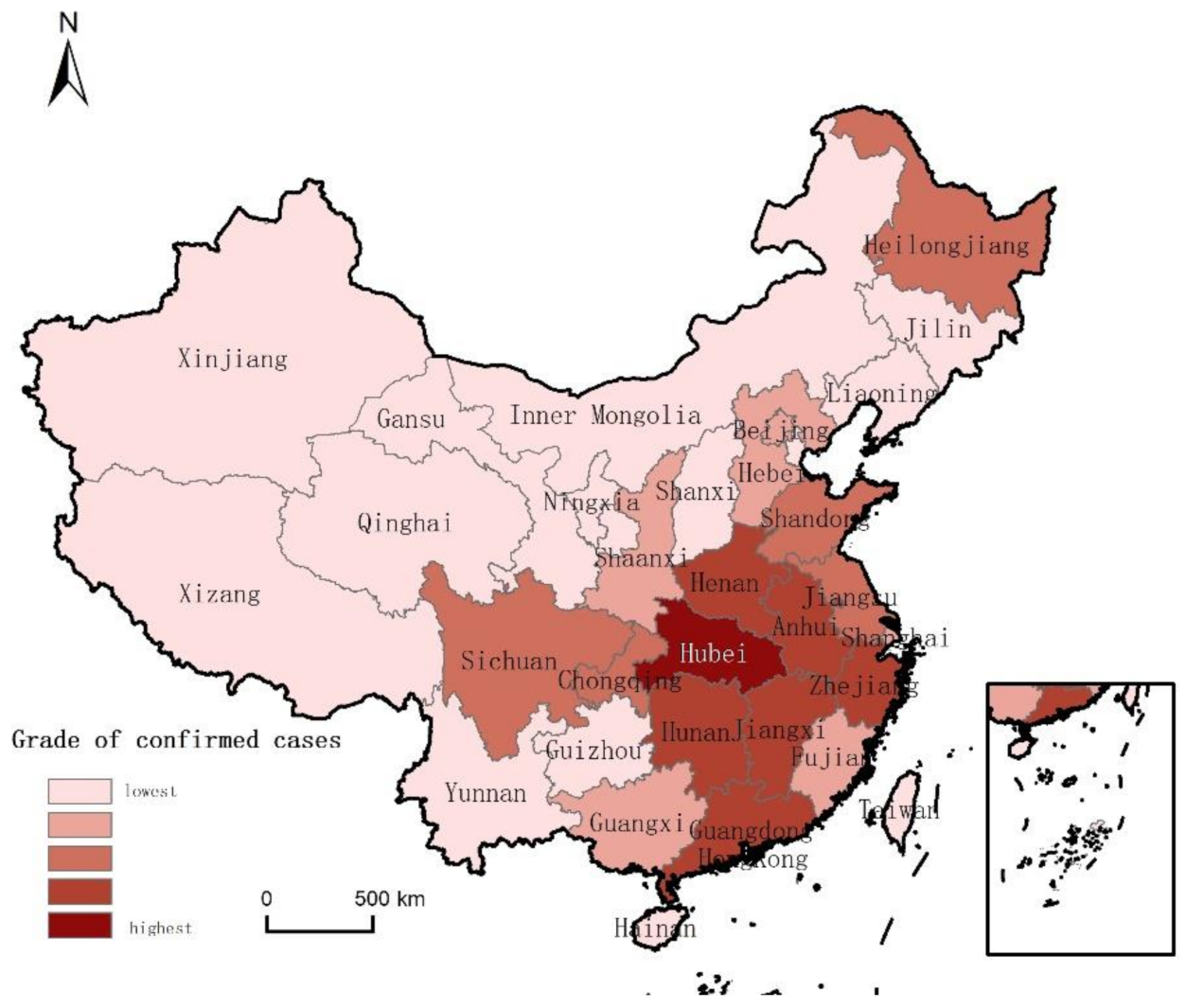
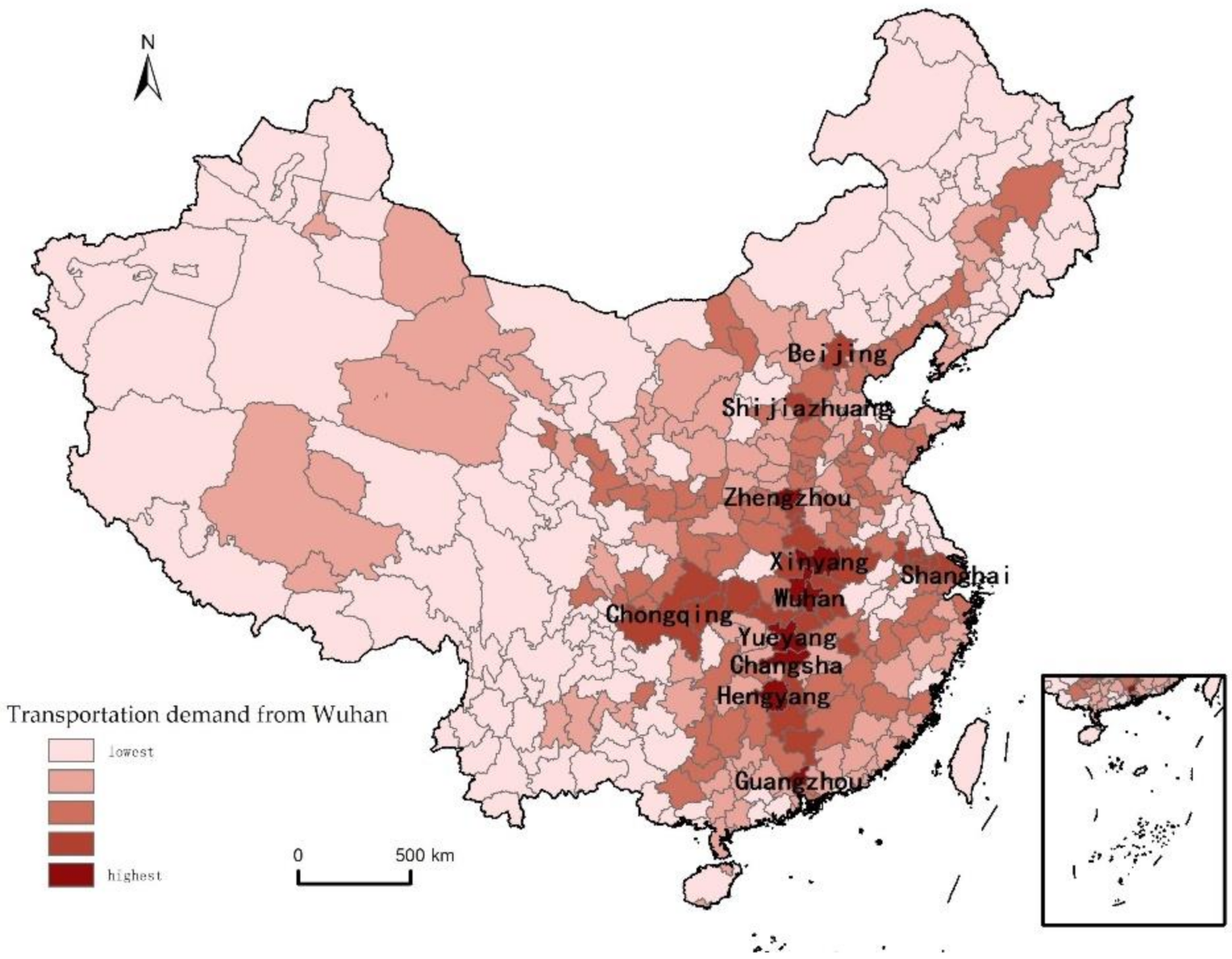
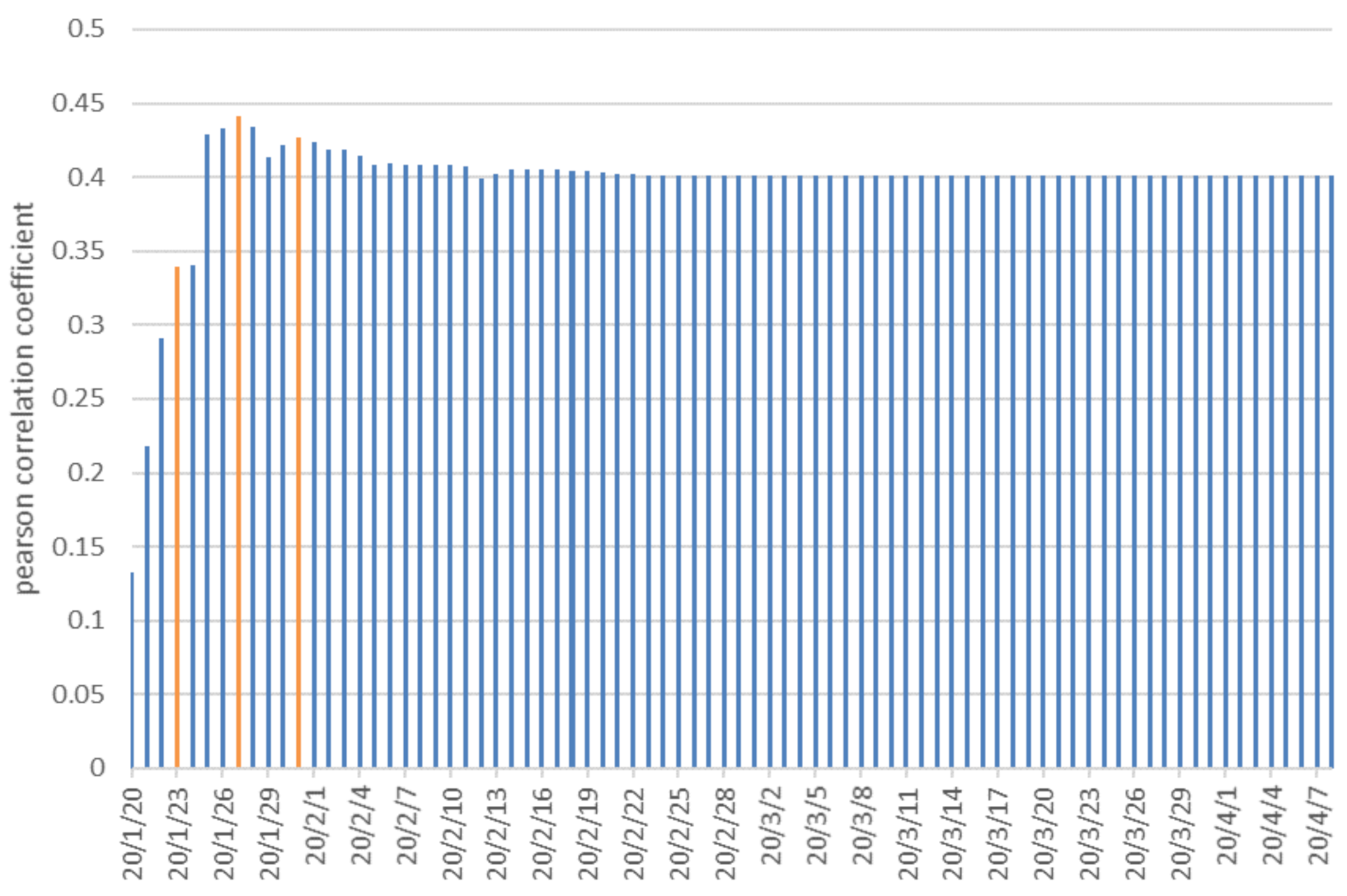

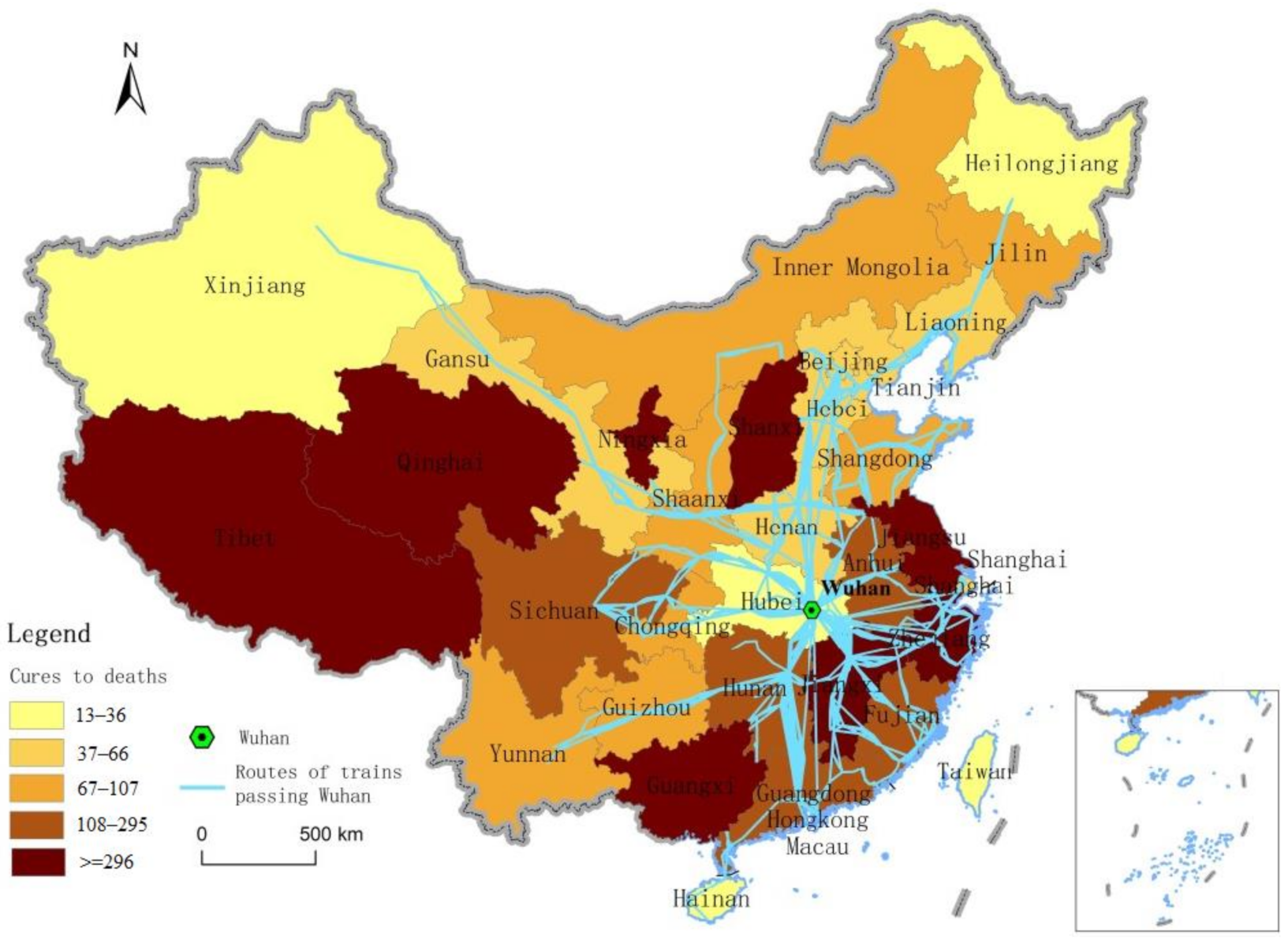

| Coef. | Std. | Err. | t | |
|---|---|---|---|---|
| b1 | 80,881.31 | 525.7646 | 153.84 | 0 |
| b2 | 0.225268 | 0.006587 | 34.2 | 0 |
| b3 | 20.27961 | 0.152884 | 132.65 | 0 |
| Provinces of Which Most Affected Area Was the Provincial Capital (Including Municipalities Directly under Central Government, Special Administrative Regions) | Provinces of Which Most Affected Areas Were Economically Developed Cities | Others of Which Worst-Hit City Was the City with More Business People |
|---|---|---|
| Hubei, Beijing, Shanghai, Chongqing, Tianjin, Heilongjiang, Jilin, Liaoning, Shaanxi, Gansu, Ningxia, Tibet, Yunnan, Guizhou, Jiangsu, Sichuan, Hunan, Anhui, Guizhou, Jiangxi, Qinghai, Fujian, Guangxi, Hong Kong, Macao, Taiwan | Guangdong, Xinjiang, Inner Mongolia, Hebei | Henan, Zhejiang, Shanxi, Shandong |
| Before Province Quarantine | After Province Quarantine | ||
|---|---|---|---|
| City | Centrality | City | Centrality |
| Beijing | 250 | Beijing | 235 |
| Shanghai | 224 | Shanghai | 208 |
| Zhengzhou | 220 | Xuzhou (rise) | 208 |
| Xuzhou | 215 | Zhengzhou (drop) | 205 |
| Shijiazhuang | 212 | Tianjin (rise) | 199 |
| Nanjing | 208 | Shijiazhuang (drop) | 197 |
| Tianjin | 208 | Nanjing (drop) | 195 |
| Zhuzhou | 207 | Zhuzhou | 195 |
| Nanchang | 203 | Shenyang (rise) | 193 |
| Shenyang | 202 | Jinan (rise) | 193 |
| Guangzhou | 201 | Bengbu (rise) | 189 |
| Jinan | 200 | Nanchang (drop) | 188 |
| Hangzhou | 198 | Guangzhou (drop) | 188 |
| Jiujiang | 192 | Hangzhou (drop) | 183 |
| Bengbu | 192 | Shangqiu (rise) | 179 |
| Suzhou | 188 | Jiujiang (drop) | 178 |
| Changzhou | 187 | Jining | 176 |
| Wuxi | 187 | Qinhuangdao (rise) | 175 |
| Shangqiu | 186 | Suzhou (drop) | 175 |
| Qinhuangdao | 184 | Jinzhou | 175 |
| Before Province Quarantine | After Province Quarantine | ||
|---|---|---|---|
| City | Centrality | City | Centrality |
| Daxinganling region | 6 | Daxinganling region | 6 |
| Chuxiong Yi autonomous prefecture | 6 | Chuxiong Yi autonomous prefecture | 6 |
| Alxa Left Banner | 6 | Alxa Left Banner | 6 |
| Wanning | 5 | Wanning | 5 |
| Beihai | 5 | Beihai | 5 |
| Bazhong | 5 | Wenchang | 5 |
| Wenchang | 5 | Qionghai | 5 |
| Qionghai | 5 | Qinzhou | 5 |
| Qinzhou | 5 | Lingshui Li autonomous county | 5 |
| Lingshui Li autonomous county | 5 | Bazhong | 4 |
| Jixi | 4 | Jixi | 4 |
| Qitaihe | 3 | Qitaihe | 3 |
| Lijiang | 3 | Lijiang | 3 |
| Xiushan Tu autonomous county | 2 | Xiushan Tu autonomous county | 2 |
| Honghe Hani and Yi autonomous profecture | 2 | Honghe Hani and Yi autonomous profecture | 2 |
| Laiwu | 2 | Laiwu | 2 |
| Fangchenggang | 2 | Fanggangcheng | 2 |
| Dali Bai autonomous prefecture | 1 | Dali Bai autonomous prefecture | 1 |
| Chongzuo | 1 | Chongzuo | 1 |
| Rikaze | 1 | Rikaze | 1 |
Publisher’s Note: MDPI stays neutral with regard to jurisdictional claims in published maps and institutional affiliations. |
© 2021 by the authors. Licensee MDPI, Basel, Switzerland. This article is an open access article distributed under the terms and conditions of the Creative Commons Attribution (CC BY) license (https://creativecommons.org/licenses/by/4.0/).
Share and Cite
Wang, F.; Niu, F. Understanding the Spread of COVID-19 in China: Spatial–Temporal Characteristics, Risk Analysis and the Impact of the Quarantine of Hubei Province on the Railway Transportation Network. Sustainability 2021, 13, 5163. https://doi.org/10.3390/su13095163
Wang F, Niu F. Understanding the Spread of COVID-19 in China: Spatial–Temporal Characteristics, Risk Analysis and the Impact of the Quarantine of Hubei Province on the Railway Transportation Network. Sustainability. 2021; 13(9):5163. https://doi.org/10.3390/su13095163
Chicago/Turabian StyleWang, Fang, and Fangqu Niu. 2021. "Understanding the Spread of COVID-19 in China: Spatial–Temporal Characteristics, Risk Analysis and the Impact of the Quarantine of Hubei Province on the Railway Transportation Network" Sustainability 13, no. 9: 5163. https://doi.org/10.3390/su13095163






